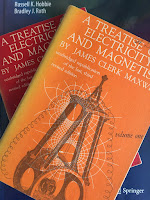The September 2010 issue of Medical Physics contains a Point/Counterpoint article titled “Ultrasonography is Soon Likely to Become a Viable Alternative to X-Ray Mammography for Breast Cancer Screening.” Arguing for the proposition is Carri Glide-Hurst, a Senior Associate Physicist at Henry Ford Hospital in Detroit. Her opponent is Andrew Maidment, Associate Professor of Radiology at the University of Pennsylvania in Philadelphia. I am in favor of the proposition, for the silly reason that I always root for the home team. (Oakland University, where I work, is about 20 miles north of Detroit, and our medical physics program has several adjunct faculty at Henry Ford Hospital.)
The 4th edition of Intermediate Physics for Medicine and Biology provides much of the scientific background needed to understand this debate. Russ Hobbie and I added a new chapter to the 4th edition that describes ultrasound and its applications to medical imaging (Chapter 13, Sound and Ultrasound). After introducing the wave equation, we describe the decibel intensity scale, attenuation, medical uses of ultrasound, and the Doppler effect. Two chapters are dedicated to understanding x rays and x-ray imaging. In Chapter 15 (Interaction of Photons and Charged Particles with Matter) we analyze the basic mechanisms by which an x-ray photon affects tissue, including the photoelectric effect, Compton scattering, and pair production. Chapter 16 (Medical Use of X Rays) focuses on applications, including a section dedicated entirely to mammography.
Magnetic resonance imaging is another modality that produces no ionizing radiation. It is described in Chapter 18 of Intermediate Physics for Medicine and Biology. However, MRI is expensive, takes a long time, and cannot be used in some patients, such as those with surgical clips. Therefore the American Cancer Society recommends MRI only for a small group of patients.
Which side wins the debate? It’s always hard to say. I’m sure the moderator, Colin Orton, chooses only those questions that do not have obvious answers. Glide-Hurst concludes her opening statement by arguing
Ultrasound poses a practical and affordable solution for screening younger women with dense breasts, pregnant females, and those who do not meet the risk level requirements of breast MRI screening. Overall, whole-breast ultrasound is advantageous because it is volumetric, noninvasive, and nonionizing, and the current literature supports the routine implementation for breast cancer screening, particularly for women with dense breasts.Maidment ends his opening statement by stating
Since ultrasound can distinguish solid tumors from fluidfilled cysts, it has a clear clinical role as a diagnostic tool in breast imaging. However, ultrasound does not appear useful for routine screening because of lower sensitivity and specificity compared to mammography, the suboptimal imaging of microcalcifications with ultrasonography, and the projected costs.All things considered, I do know who wins the debate. The winner is the reader, who witnesses two experts carefully weighing the evidence, analyzing the physics, and predicting future trends. I encourage any student reading Intermediate Physics for Medicine and Biology to also browse through recent issues of Medical Physics. If, like me, you’re often short on time, skip the articles and just read Point/Counterpoint. You won’t regret it.




